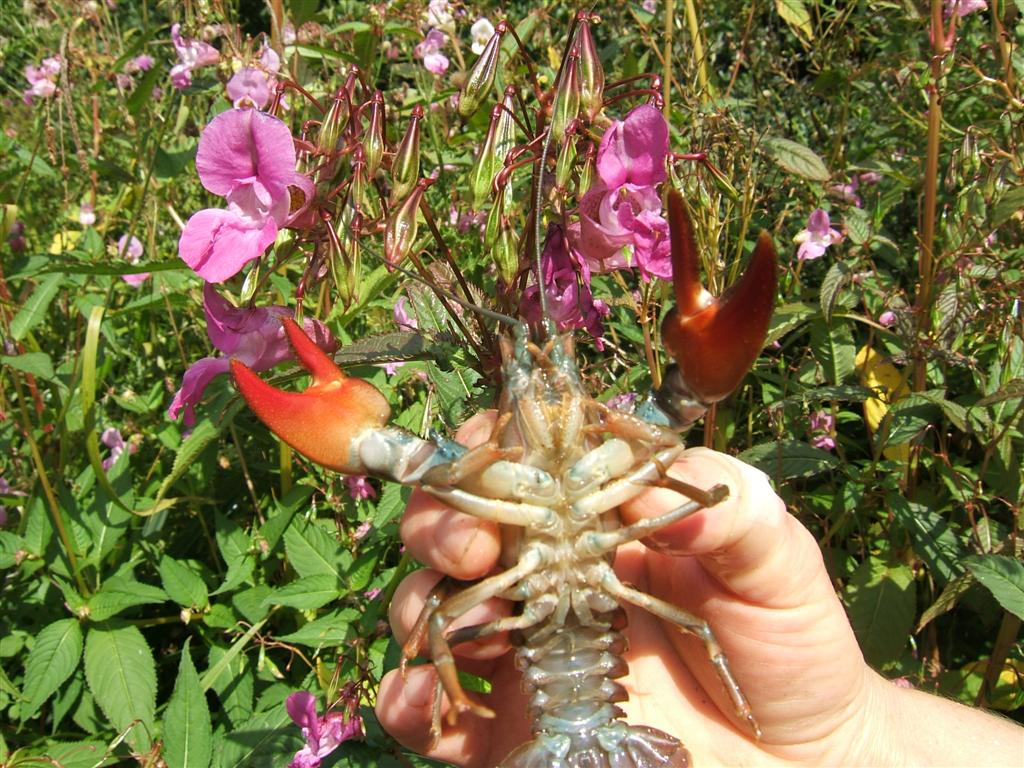Waters free of invasive non-native species
Many species have been introduced to this country by humans and have a benign presence. However, a number have spread as invasive species, unchecked by their natural predators or pathogens, causing significant harm to native species and human interests.
Himalayan balsam can be found in all river catchments in the Peak District, and left unchecked can quickly form large monocultures that swamp out our native plant life, then leave banks open to erosion once it has died back.
Japanese knotweed causes problems with the natural and built environment, and is difficult to remove once established.
Mink, escaped or released from fur farms, have become a serious predator of our native water vole, and are one of the main reasons for their decline.
The white-clawed crayfish (opens new window) is in serious trouble and is globally endangered due to non-native species and habitat loss. The introduction of non-native crayfish, particularly North American signal crayfish, has been catastrophic for our native white-claws. Signal crayfish have spread the devastating ’crayfish plague’, to which our native crayfish have no immunity, and has wiped out entire populations in a matter of weeks. Non-native crayfish also aggressively outcompete the smaller white-claws for food and shelter.
The GB Non-native Species Secretariat (opens new window) is responsible for co-ordinating the approach to invasive non-native species in Great Britain.
# For nature
- Removing invasive non-native species can allow some of our native species to begin to recover their populations. Healthy populations of native species will help make them more resilient for the future.
- Many non-native species spread quickly along river corridors. By removing them from our water environments, we can slow or stop the spread to other areas where they might have negative impacts on a wide variety of wildlife.
- The activity around tackling invasive species may have consequences for other wildlife; for example, work may have to be carried out during the bird breeding season.
- The Peak District holds an important moorland population of water vole that use the streams and gullies, but also the rewetted blanket bog. As restoration works continue, they are likely to become more terrestrial, spreading out over the peatland. For now, these voles are safe from mink, which don’t tend to venture into the moorland habitats from the rivers.
# What else can removal of invasive non-native species deliver?
- Flood prevention and clean water by slowing or stopping bank erosion and sediment run-off.
- Tackling invasive non-native species can often be costly, taking vital funds away from other work.
- Removing Japanese knotweed can increase property value.

# In practice
- Most invasive non-native species are listed under Schedule 9 (opens new window) of the Wildlife & Countryside Act in England & Wales 1981 (as amended). For plants, this means it is an offence to plant or otherwise cause them to grow in the wild, and for animals to distribute or allow release into the wild.
- A coordinated, partnership approach can help tackle invasive non-native species in a coordinated way at scale. Many people, including fishing clubs, trap and kill American mink across the Peak District, but this work is currently not widely coordinated or recorded.
- Non-native species removal should be part of all site management.
- For plants that are easy to spread, keeping them from growing on or near footpaths and other heavily-used areas will minimise spread to new areas.
- Hand pull, cut or strim every Himalayan balsam plant before they begin to form seed pods. Even one missed plant can cause seed to spread, and may infest new areas.
- Japanese knotweed is controlled by targeted spraying of weed killer.
- Coordinated mink control, using live-capture traps and humane, safe and targeted dispatch.
- ‘Check, clean, dry (opens new window)’ biosecurity methods avoid spreading crayfish plague, which can remain active on damp gear for 22 days.
- Trees such as alder and willow along riverbanks can provide shade and root systems for crayfish to use.
- There is no proven technique for eliminating signal crayfish. It is illegal to trap and catch any crayfish without a licence from the Environment Agency (opens new window).
- Create ‘ark’ sites, where white-clawed crayfish can be kept separately from invasive species. More research is needed to investigate the potential co-habitation of native and non-native crayfish.